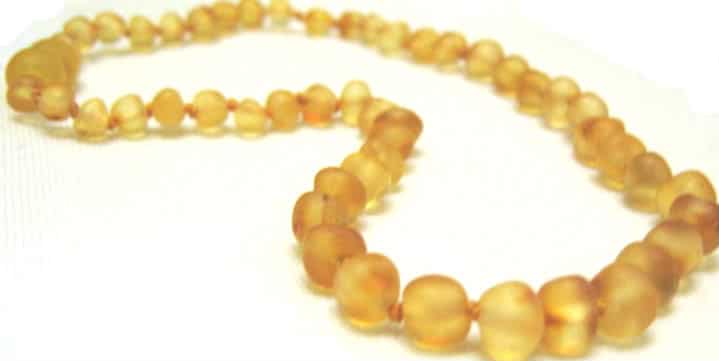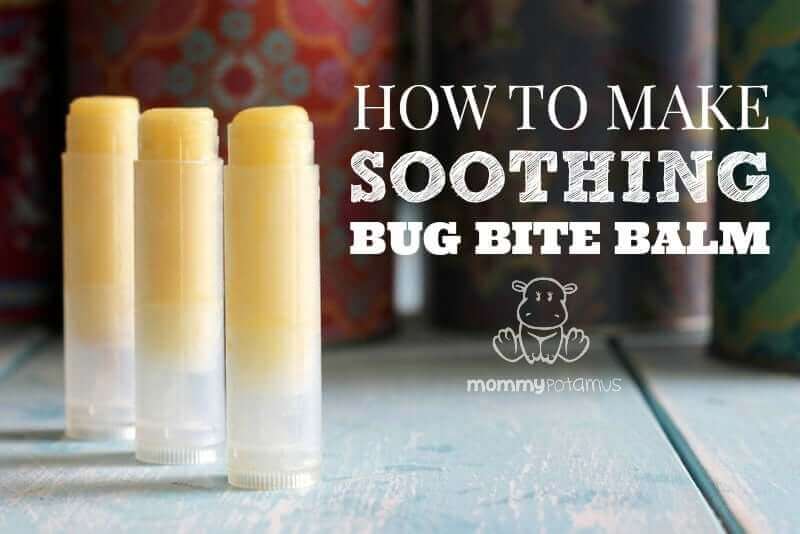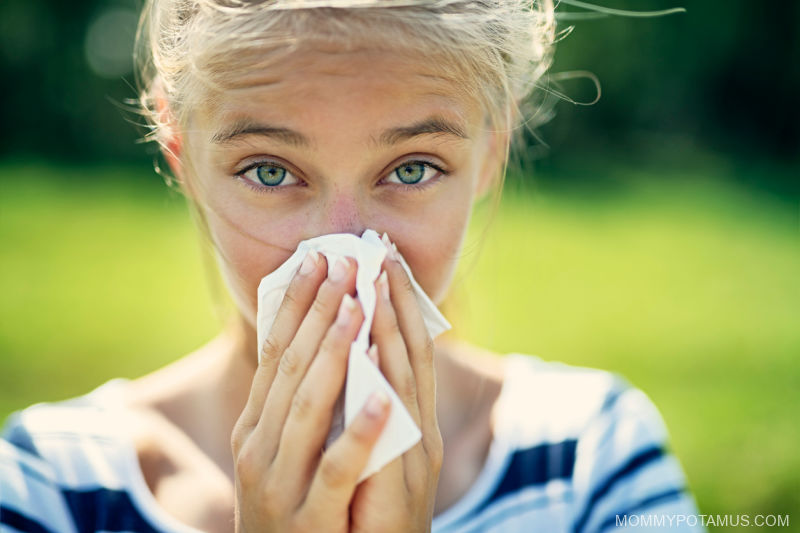
When you think of the transition to spring or fall, does your mind wander to soaking up lots of beneficial sunshine, planting a garden, or maybe sipping on pumpkin spice lattes . . . or do you think of watery eyes and stuffy sinuses?
If you’ve ever spent allergy season trying to remember what it’s like to breathe out of more than one nostril, read on. My coauthor – herbalist Lori Rose PhD, CNP, BCHN, RH (AHG) – and I will cover six at-home remedies to reach for the next time you are swimming in seasonal sniffles.
We’ll also share some tools you can use before allergy season to help prepare your body.
- So, what causes seasonal allergies?
- What are the symptoms of seasonal allergies?
- 6 Natural Remedies for Allergies
- 1. Neti Pot or Saline Spray
- 2. Herbs & Antioxidants
- Quercetin With Bromelain
- Butterbur
- 3. Spicy Foods
- 4. Cold Compresses
- 5. Steam
- 6. Reduce Overall Allergen Exposure
- Other Things To Try:
- Know someone who could use some natural allergy support?
- Want more research-backed natural remedies?
So, what causes seasonal allergies? ^
It’s fairly safe to say you’ve probably heard of antihistamines before – the over-the-counter medications that are sold to relieve allergy symptoms. But what are histamines exactly, and how do they work?
One of the easiest ways to understand them is to think of your body as a bathtub, histamines as water and your ability to break them down as the drain.
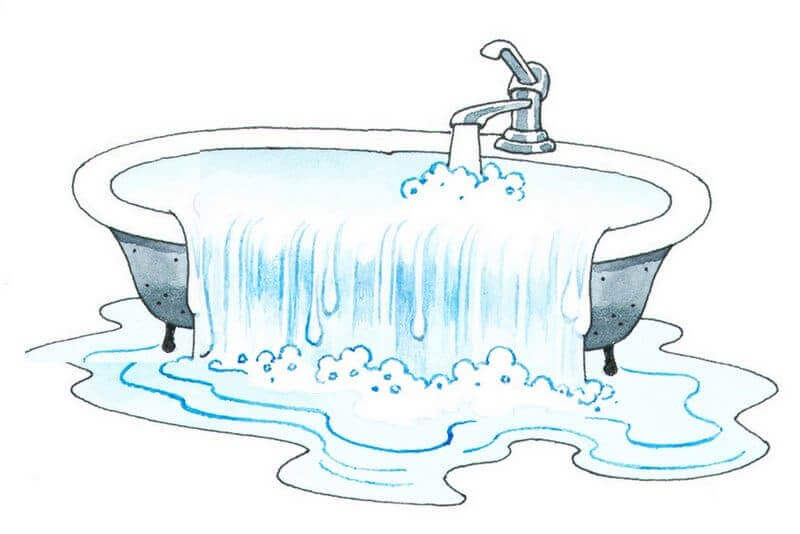
When our bodies encounter pollen, grass, mold, cedar, ragweed, pet dander, dust mites and other airborne compounds, our immune system may see them as invaders or irritants that need to be dealt with. It then triggers the release of histamines which increases blood flow to the affected area, cause inflammation, and sometimes lead to the production of mucus. (1)
Mucus is the body’s way of capturing unwanted invaders and then pushing them out as you blow your nose, wipe your watery eyes, etc. When histamine has done its job, your body breaks it down using two enzymes called diamine oxidase (DAO) and histamine N-methyltransferase (HMT).
At least that’s how it’s supposed to work.
If the body’s drain is clogged or the water is coming in too fast for it to keep up, the tub will eventually overflow and cause allergy symptoms – lots of mucus, itchiness from inflammation, and more.
For some people, allergy season feels like the faucet has been turned on full blast – pollen everywhere! Fortunately, there are things we can do to slow down the faucet a little and open up the drain so we can feel better.

What are the symptoms of seasonal allergies? ^
Sometimes called hay fever or allergic rhinitis, seasonal allergies often cause symptoms including:
- Runny or stuffy nose
- Puffy, itchy or watery eyes
- Dry eyes or throat irritation
- Sneezing
- Fatigue
- Headache
6 Natural Remedies for Allergies ^
When symptoms have already started, using a few different remedies together can work synergistically to help. Here are our top five:
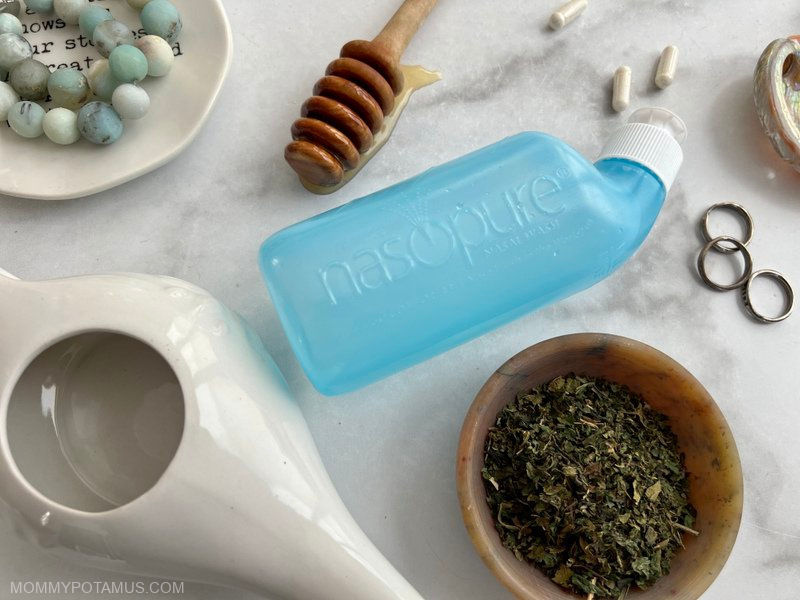
1. Neti Pot or Saline Spray ^
Reducing allergen load – or the amount of allergens the body has to deal with – is one of the best strategies for easing irritation. One of the easiest ways to do that is to rinse away allergens from the upper sinuses with a neti pot or saline spray.
Neti pots have been used in India for thousands of years to keep sinuses clear, and current research supports their traditional use. They’re thought to help by rinsing away allergens, and also by helping thin out mucus that has already formed so that the body can get rid of it.
In this meta-analysis, researchers concluded that both neti pots and saline sprays reduced the severity of seasonal allergy symptoms. Another study published in the International Archives of Allergy and Immunology found that nasal irrigation significantly improved symptoms in kids. (2)
And in this study, researchers concluded that nasal irrigation improved breathing and sleep quality due to the reduction in symptoms.
So are neti pots better than saline sprays or vice versa? When deciding whether to go with a neti pot or saline spray, here are some things to consider:
Benefits of Neti Pots
- Neti pots can rinse away allergens that are deeper in the sinus cavity
- There’s more research on the benefits of neti pots (but the research we do have on saline sprays is positive)
Downsides of Neti Pots
- To use a neti pot, you either need to have distilled water on hand to make a saline solution or boil water for 3-5 minutes and then let it cool before making your saline solution. Tap water straight from the faucet, even if you have a water filter, should never be used unless it is boiled first. If you’re rinsing daily (or three times per week once symptoms have calmed down), boiling water or remembering to pick up distilled water at the store can become a hassle.
- Some kids resist using them. I prefer Nasopure bottles to traditional neti pots because they’re easier to use, especially for kids. Nasopure was developed by a pediatrician and comes with pre-measured salt packets to make a gentle but effective saline solution.
Benefits of Saline Sprays
A couple of years ago my trainer told me, “The best exercise for you is the one you’ll actually do consistently,” and I’ve used that bit of wisdom in so many areas of my life since then.
Unlike neti pots which can feel like a hassle, saline sprays are quick and easy to use. Kids tend to like them because they disperse saline more gently and are less messy, too.
This saline spray is amazing for kids and adults who feel like the neti pot takes too much prep work. It has better ingredients than other brands, and it’s safe for babies, too.
Downsides of Saline Sprays
There isn’t as much research on saline sprays as there is on neti pots, but what is available is positive.
2. Herbs & Antioxidants ^
Although the herbs and antioxidants we’ll discuss below can be used on their own, they are also often combined into synergistic blends. One product – Sinus & Seasonal from RES Labs – was formulated with all of them for the purpose of supporting sinus health.
Although none of these herbs are FDA-approved as treatments and should not be considered as such, research suggests they may support our bodies natural processes for dealing with seasonal transitions.
Unlike nasal irrigation and some of the other methods in this article that tend to have immediate (or nearly so) effects, the herbs in this article are considered most helpful when taken consistently over time.
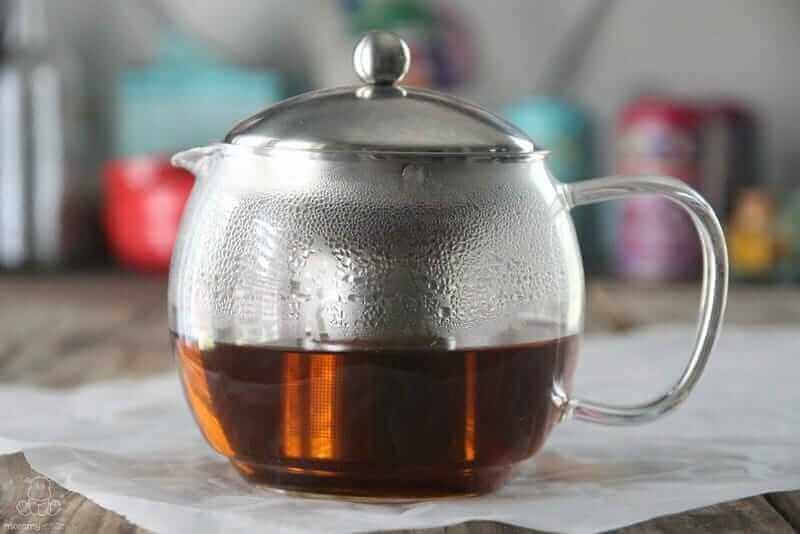
Nettle Capsules Or Tea
I was just a toddler when my parents built a cabin on 40 acres of prairie in Texas, but I still vividly remember stumbling into patch after patch of stinging nettle (Urtica dioica) while trying to gather wildflowers. Though I loathed nettle back then, today it’s one of my favorite herbs.
As Katja Swift and Ryn Midura write in Herbal Medicine for Beginners, “Nettle tea is, above all, a multivitamin and mineral supplement in a teacup! One of the most mineral-rich land plants, nettle, when taken regularly, can resolve many issues resulting from the lack of minerals in modern diets.” They add that:
Nettle is one of the best supports for seasonal allergies – not only because of its strong kidney-supporting actions, but also because nettle can stimulate the liver’s anti-histamine production.”
How To Take Nettle
Many herbalists swear by freeze-dried nettle, which preserves the formic acid in the nettle stingers. I like these capsules because they’re made from raw, wildcrafted freeze-dried nettle. In terms of amount, one study concluded that 300 mg daily was helpful, while other sources recommend one 300 mg capsule 3 times per day. (3)
Other herbalists say that similar relief can be found from dried (not freeze dried) nettle tea, so you may want to experiment and see what works best for you. Here’s how to make nettle tea.
Safety of Stinging Nettle
According to the Botanical Safety Handbook: 2nd Edition, nettle is a Safety Class 1A herb, which is the safest rating possible. This class of herbs is described as:
“Herbs that can be safely consumed when used appropriately.
- History of safe traditional use
- No case reports of significant adverse events with high probability of causality
- No significant adverse events in clinical trials
- No identified concerns for use during pregnancy or lactation
- No innately toxic constituents
- Toxicity associated with excessive use is not a basis for exclusion from this class
- Minor or self-limiting side effects are not bases for exclusion from this class”
Quercetin With Bromelain ^
Quercetin is a bioflavonoid that studies suggest may support the stabilization of mast cells, which are the immune cells that release histamine. (4) It’s found naturally in elderberries, apples, parsley, tomatoes, broccoli, fresh sprouts, lettuce, wine, and other foods and drinks, so focusing on diet can be very helpful.
Most of the studies on quercetin have been done with supplements, though, because it’s much easier to determine when a participant’s intake has reached a therapeutic range. Quercetin supplements are relatively affordable and very popular for supporting the stabilization of mast cells and a healthy overall inflammatory response.
Quercetin is often paired with bromelain, which an enzyme found in pineapples. Bromelain is also an antioxidant, and studies suggest it may support the body’s natural ability to clear mucus. It also appears to work synergistically with quercetin, which is why many supplements pair the two antioxidants together.
Sources & Safety Considerations
Onions have the highest level of quercetin compared to other tested produce, containing approximately 300 mg per kilogram (about 2.2 pounds). Kale, cherry tomatoes, broccoli, blueberries and apples are also high in quercetin.
When taken as a supplement, the most common dose is 500 mg per day, but some people take up to 1,000 mg per day. (5) In this study, participants took 500 or 1000 mg/day quercetin or a placebo for 12 weeks. The safety of longer-term use is not established.
The United States Food and Drug Administration (FDA) classifies quercetin as a generally safe substance.
Some people reported minor side effects when taking high doses of quercetin, such as 1,000 mg per day, long-term.
Side effects may include:
- headaches
- nausea
- tingling sensations
Quercetin may interact with some medications, so people should ask their doctor before taking a supplement.” (6)
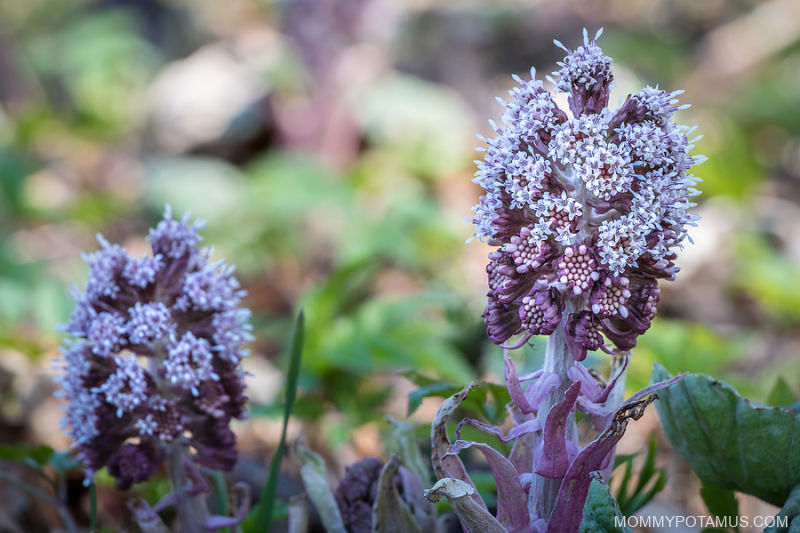
Butterbur ^
Used since the 17th century to support the upper respiratory tract, butterbur (Petasites hybridus) is one of the most well-researched herbs for seasonal issues. (7) (8)
In a meta-analysis of 16 studies, this member of the daisy family was found to ease discomfort associated with seasonal allergies without causing drowsiness. (9)
Safety of Butterbur
Petasins are considered the therapeutic constituent in butterbur, so butterbur extract is usually standardized to ensure that a certain amount of them are present in the supplement. However, there’s another important reason butterbur is standardized (aka processed) rather than sold in its whole-herb form.
Raw butterbur contains compounds called pyrrolizidine alkaloids (PA) that can cause liver damage and may also be carcinogenic. For that reason, only extracts which filter out pyrrolizidine alkaloids and are labeled as PA-free should be considered.
Though PA-free butterbur is generally well-tolerated, keep in mind that:
- Allergic reactions have been reported in people with allergies to plants in the Asteraceae/Compositae family, such as ragweed, daisies, marigolds, and chrysanthemums.
- If side effects do occur, the The American Pharmacists Association notes that “GI symptoms, including belching, diarrhea, and stomach upset, have been reported most commonly, along with fatigue and dizziness. (7)
Butterbur products should not be used during pregnancy or by breastfeeding women.
Ways To Take Butterbur
Butterbur is usually taken as a standardized extract. In this study, participants were given a butterbur leaf extract called Ze 339 – which contained 8 mg of petasin – 2-3 times per day for up to two weeks. They found this amount to be “safe and efficacious.”
Also, “Several studies, including a few studies of children and adolescents, have reported that PA-free butterbur products are safe and well tolerated when taken by mouth in recommended doses for up to 16 weeks. The safety of longer-term use has not been established.” (10)
3. Spicy Foods ^
Foods that pack some heat – cayenne pepper and those found in fire cider for example – can help get things flowing again, so make sure to have your tissues ready when you try them. They can also be helpful for easing overall pressure and tension around the sinuses.
If you don’t already have a batch of fire cider whipped up, you probably don’t want to wait 2-4 weeks for it to be ready. Fortunately, you can have pre-made fire cider delivered quickly if you have Amazon Prime or choose expedited shipping. In terms of how much to take, many people opt for 1-2 tablespoons every three to four hours if symptoms are present.
Another option is to make lemon ginger tea and add cayenne pepper.
4. Cold Compresses ^
Cold compresses are a great way to soothe itchy eyes. To make one, fill a small bowl with ice and water, then dip a soft washcloth in it and wring out the excess water. Fold the washcloth so that it’s roughly the size of an eye mask, then lay back and place the cloth over your eyes for 5-10 minutes.
Small bags of frozen peas that have been wrapped in cloth will work, too.
5. Steam ^
Inhaling steam can help to thin mucus so you can breathe easier. (13) The easiest method is to pour just-boiled water into a bowl and place a towel over your head to form at “tent” that traps the steam. Make sure to maintain a comfortable distance from the water so that the steam doesn’t scald you.
If desired, you can add dried rosemary or thyme to the water. When heated they will release essential oils that are thought to increase the therapeutic effects of the steam.

6. Reduce Overall Allergen Exposure ^
Though we’ve already covered one of the best ways to reduce allergen load – nasal irrigation – there are several other strategies that may help as well:
- Leave your shoes at the door so you don’t track pollen into the house.
- Shower after spending time outside. A hot shower helps rinse away allergens from skin and hair after spending time outside, which prevents them from transferring to clothes, bedding, and furniture. It’s also a great way to inhale some soothing steam.
- Make use of HEPA filtration. Air purifiers with HEPA filters are able to capture dander and other allergens that are floating around in the air, and HEPA vacuums remove ones that have settled to the floor. Because they don’t trap particles effectively, regular vacuums tend to push allergens back into air circulation. This HEPA vacuum was voted best budget pick by Prevention Magazine, and you can find my top recommendations for home air purifiers here.
- Keep your windows closed when the pollen count is high.
Other Things To Try: ^
Probiotic Foods & Supplements: Probiotics may also “help take some of the misery out of hay fever, or seasonal allergies, according to a new review of studies.” (11)
For example:
- A 2017 study conducted at the University of Florida found that a probiotic combination of lactobacilli and bifidobacteria (product name Kyo-Dophilus) eased hay fever symptoms in a group of adults with seasonal allergies. Because strain matters, I want to mention that the particular ones studied were Lactobacillus gasseri KS-13, Bifidobacterium bifidum G9-1, and Bifidobacterium longum MM-2. (12)
- Another small study found that Bifidobacterium lactis NCC2818 was helpful for easing symptoms associated with grass pollen
However, researchers have noted that we don’t have enough information to make specific recommendations yet. Of the 23 studies reviewed only 17 showed a benefit, and those studies used a wide variety of strains, dosages and outcome measures. More research is definitely needed, so for now the takeaway seems to be that:
“The studies on the connection between probiotics and the prevention of allergic rhinitis are, more than anything, showing us that gut health is critical to the immune system” – Will Bulsiewicz, M.D
Honey: Many people believe eating a daily spoonful of local, raw, organic honey specific to your region can help your immune system build a tolerance to any local allergens.
Adaptogenic Herbs: Adaptogens are herbs that help the body adapt to stress, including physical stressors like exposure to an allergen. It may be helpful to drink (or take as a tincture) adaptogens like astragalus and/or reishi 1-3 months before allergy season begins.
Liver Support: Your liver’s job is to filter out allergens, toxins, metabolic byproducts, used hormones and other compounds like excess histamine. To reduce the likelihood of your liver getting overwhelmed with too much to process – thus reducing its ability to clear histamine – you can decrease your exposure to environmental toxins, processed food, sugary foods (which your liver also has to process), and allergens themselves.
Allergens can include common allergenic foods like gluten, dairy, corn, soy, and eggs, or foods that specifically affect your body (which can be decreased by addressing leaky gut). They may also include the family pet – if that’s the case, an air purifier may be particularly helpful.
There are several other ways to support liver detoxification, too, including this DIY Liver Love Tincture, sulforaphane-rich foods, and herbs like dandelion root, which is delicious when roasted and brewed as a tea.
Himalayan Salt Inhalers: Salt therapy – also called halotherapy or speleotherapy – involves breathing in fine salt particles. Although the sea air does contain salt, dry salt (found in salt caves and salt inhalers) is considered a more potent form of halotherapy. Some people find personal Himalayan salt inhalers to be helpful during seasonal transitions.
This article was medically reviewed by Dr. Mariza Snyder, a functional practitioner. As always, this is not personal medical advice and we recommend that you talk with your doctor.
Know someone who could use some natural allergy support? ^
Please share this article with them, and let me know in the comments if you have a favorite remedy that I didn’t include.
Want more research-backed natural remedies? ^
No problem, I’ve created a free ebook for you – Kitchen Apothecary: 25+ Natural Remedies Using Ingredients From Your Pantry – as a gift for signing up for my newsletter. You’ll also get updates when I post about safe essential oils for pregnant/breastfeeding mamas, exclusive gifts and coupons (I was able to give away a jar of free coconut oil to anyone who wanted it recently!), plus other goodies.
Sign up using the form below.
This article was medically reviewed by Dr. Mariza Snyder, a functional practitioner. As always, this is not personal medical advice and we recommend that you talk with your doctor.
About the authors: This article was co-authored by Heather Dessinger and Dr. Lori Valentine Rose (PhD). Dr. Lori is a college biology, nutrition, herbal, and wellness instructor, Certified Nutrition Professional (CNP), Registered Herbalist with the American Herbalist Guild, and is Board Certified in Holistic Nutrition. She created, developed, and instructs the Hill College Holistic Wellness Pathway, the most thorough, affordable, degreed wellness program in the country. She loves spreading love and light, and helping others feel awesome on the inside and out so they can live their dreams and make this world more awesome!
Sources
1. WebMD (2020) What Are Histamines?
2. Garavello, Warner et. al. (2005) Nasal rinsing with hypertonic solution: an adjunctive treatment for pediatric seasonal allergic rhinoconjunctivitis
3. Dr. Christopher’s Herbal Legacy. Stinging Nettle
4. Horowitz, Randy (2018) Integrative Medicine
5. Andres, Susanne et. al. (2017) Safety Aspects of the Use of Quercetin as a Dietary Supplement
6. Medical News Today (2019) What are the benefits of quercetin?
7. National Center for Complementary & Integrative Health. Butterbur
8. National Center for Complementary & Integrative Health. Seasonal Allergies At A Glance
9. Guo, Ruoling et. al. (2007) Herbal medicines for the treatment of allergic rhinitis: A systematic review.
10. Doherty, Colleen (2020) The Health Benefits of Butterbur
11. WebMD (2015) Probiotics May Ease Hay Fever Symptoms
12. Science Daily (2017) Allergies? Probiotic combination may curb your symptoms, new study finds
13. WebMD. How do I use steam for congestion?

